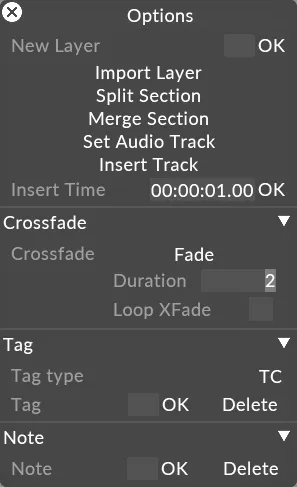Universal Crossfade
Universal crossfade smoothly transitions between any two points in a show when jumping within or between tracks.
Specifying when a crossfade occurs
Section titled “Specifying when a crossfade occurs”By default, there is no crossfade - all jumps are hard cuts. In order to change the behaviour, the user has the option of changing the crossfade settings in a number of locations:
- Globally across the entire project: open the state manager by right clicking the d3 icon on the top left of the gui, navigate to Project Settings and see option Global Crossfade Duration.
- Per-track: right-click on the track title bar, select Special settings, switch Default Crossfade to Fade or TrackSection, and select the transition time you want to use.
- Per section: right-click on the first bar of the section, under the Crossfade tab, select either Fade or TrackSection and configure the parameters accordingly.
The crossfade behaviour is taken from the most-local crossfade selection, in order: Section, then Track and finally Global. If a crossfade option is ‘Undefined’, the next option is checked. If all options are undefined, a hard cut is performed.
The fade is started under two circumstances:
- Jumping to another point on the timeline
- Holding at the end of a section and going forward into the next section
Crossfade loop
Section titled “Crossfade loop”The crossfade behaviour when looping a section has some customisation options: When in loop section playmode, the playhead can crossfade to the beginning of the current section x seconds before the end of the section. Where x is the duration of the fade or the length of the specified track section used to render the transition. This helps create a more seamless fade back to the start of a section rather than a hard cut.
- Right-click on a section and set the transition as desired.
- Check Loop XFade box.
- The section will now fade back to the beginning using the duration set.
Types of crossfade
Section titled “Types of crossfade”Crossfades can be accomplished using two methods:
- Fade - a dissolve from the original position to the new position, specified in seconds (including fractions of a second.)
- TrackSection - a dissolve controlled by a separate track sequence which uses content which begins with a black screen and ends with a white screen. The duration is controlled by the length of the track section.
Fade transitions
Section titled “Fade transitions”This option provides a straight linear dissolve across all screens across the specified time period. All channels are dissolved at the same rate, including alpha.
Setting up a fade transition
Section titled “Setting up a fade transition”- Right-click a section.
- Set the crossfade from Undefined to Fade.
- Set the duration to be whatever time you wish the fade to occur over.
- The beginning of each section shows a triangular indentation the length of the fade duration to indicate that jumping into the section will initiate a dissolve of that duration. The duration is always controlled by the destination section.

Sequenced transitions (TrackSection)
Section titled “Sequenced transitions (TrackSection)”To achieve more control over the transition behaviour, the user can sequence a transition instead of a predefined fade, which only allows a straight dissolve. The transition uses normal track sequencing, allowing any layer type to be used.
- Individual RGBA components are actually transitioned independently.
- All layer types are expected to work except those which deal with transport commands or status. Examples include:
- TransportVolumeLocal
- TransportBrightnessLocal
- TransportControl
- TrackJump
- Readout
- Audio is played back during transitions. This is to allow an audio component to the transition.
- Prefetch is not performed - any ‘heavy’ video files will likely fail on the first frame. A workaround would be to offset the transition video forward by a frame or two.
Setting up a sequenced transition
Section titled “Setting up a sequenced transition”- Create a track called “transitions”.
- Create sections within the track that define your transition lengths.
- Within your section, sequence content starting black, and ending white. Playmode should be set to “pause at end”. a. Note that each channel is dissolved independently. If working in multi-transport, alpha can be important to the transition sequencing.
- Give the section a name by using a note.
- On your main show track, right click a section to define a section based crossfade. This can also be set via Telnet when using the Multi-transport API.
- Choose “Track Section” in place of the crossfade override.
- Choose the “transitions” track and the desired transition section to use.